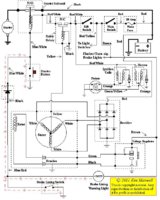freddy3
XS650 Addict
- Messages
- 479
- Reaction score
- 120
- Points
- 43
Should the green resistor(?) on the regulator plate become too hot to touch within one minute of the engine starting?
The bike is a stock 1972 XS2, which I've owned since '75.
Last week, a day after I'd washed the bike like I normally do, within a couple of minutes of starting the engine, both battery leads along with the in-line battery fuse (behind the left-side cover) and rectifier became so hot that I couldn't touch them. I shut the bike off and then disconnected the battery leads. I've never seen battery leads get hot like that!
After everything cooled down, I tried to start the engine again, but the battery was then dead. No green neutral light came on in the tach (or is it the speedo?....whichever). So I charged the 2 year-old Die Hard battery and tried again the next day.
This time, the bike started normally and the battery leads were cool, but I found that the wires leading from the rectifier to the battery fuse (under the left-hand side cover) were again very hot, as well as the center bolt in the rectifier body that holds the rectifier onto the frame were scalding hot! So I shut the engine down and inspected the rectifier, since I'd had a similar problem many years ago (which turned out to be a bad rectifier).
As it turned out, the inside of the rectifier was pretty corroded (I have a feeling that water's getting into the rectifier body when I was the bike and it then rusts and corrodes) and it looked like the corrosion may've bridged some of the rectifiers, causing them to short. So I took the rectifier apart and cleaned it out thoroughly, removing all of the corrosion and potential shorts. It looked nearly new.
Upon restarting the engine, all the components that had previously gotten hot seemed to be fine. So I took the bike out for a 3-hour drive and as I was just a few blocks from returning home, the engine started to die while sitting at a stop light. Cutting to the chase....the battery had discharged. Or, it wasn't getting charged?
So I checked the voltage regulator to see if it'd been damaged by the heat the previous day and found it was putting out ~14.9 volts to the battery, which is within the normal range. Otherwise, everything seemed fine except that the green resistor on the voltage regulator plate is becoming too hot to touch within a minute of starting the engine.
My question is whether it's normal for that resistor to get so hot (and I just never noticed it before), or does that indicate that the regulator, rectifier or some other component is defective/damaged (even though the system's sending the correct voltage to the battery)?


